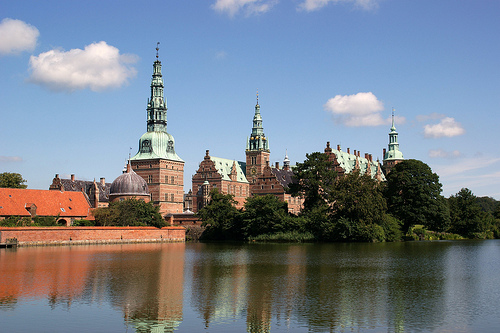

Location: Frederiksborg Slot 11 3400 Hillerød, Zealand Map
Tel. 42 26 04 39
Open: Apr- Sep: 10am- 5pm daily
Oct- Mar: 11am- 3pm daily
Baroque gardens: 10am- sunset
Frederiksborg Castle is located in Hillerød,
Zealand region of Denmark. Royal residence is spread over three
islets in the middle of the Slotssøen Lake. Construction of
Frederiksborg Palace started in 1560 by king Frederik II who also
gave the chateau its name. Most of the structure, however, was
constructed by Frederik II's son, Christian IV in Renaissance style.
Between 1671 and 1840 all Danish monarchs were crowned in the small
chapel of the Frederiksborg Palace. Frederiksborg Palace was badly
damaged during sweeping fire of 1859, but in 1860- 84 it was
reconstructed with help of brewer J.C. Jacobsen and later Carlsberg
Foundation. Some additions included The National History Museum and
an impressive collection or portraits, historical paintings and
modern art. Newly renovated palace was open to all citizens on
February 1882.
Palace chapel constructed by Christian IV
houses an organ built by Esajas Compenius since 1610. It escaped the
great fire in the 19th century. Small chapel adjacent to
Frederiksborg Castle was used to crown many Danish royals is still
used today occasionally. This includes Prince Joachim and Princess
Alexandra who were crowned here in November 1995. Another structure
that survived damage by a devastating fire is a Bath House Palace
(Badstueslot). It is one of the original structures of Frederiksborg
Palace erected by its founder Frederik II.
History
The first castle on the site of
Frederiksborg was founded in 1560 by King Frederick II and was named
Hillerødsholm after the nearby town. In 1599, his son Christian IV
started rebuilding his favorite country residence, which he gave the
name of his father, Frederiksborg.
The final chord of
construction work was the installation of a fountain with a statue
of Neptune in front of the main entrance to the palace in 1622,
symbolizing the rule of Christian IV over the northern seas. Bronze
figures for the fountain were sculpted in Prague by the recognized
master of mannerism, Adrian de Vries. After the Roskilde Peace, the
Swedes took the fountain to Drottningholm; in 1888 a copy took its
place.
In 1693, the palace chapel was transferred by the king
to the orders of the Elephant and Dannebrog. From 1671 to 1840, all
Danish monarchs were crowned in this chapel.
On a cold night
from December 16 to 17, 1859, King Frederick VII demanded that the
fireplace be lit in the castle, although the chimney was being
repaired. The result was a big fire that left Frederiksborg in
ruins.
Immediately after the fire, Danish merchants led by
the brewer Jacobsen began raising funds for the reconstruction of
the shrine of national history. The reconstruction was completed by
February 1882. Under the auspices of the Carlsberg Foundation
founded by Jacobsen, the National History Museum was organized on
the castle squares.
Museum
The Small Knights 'Hall on the
first floor and the Great Knights' Hall on the second floor were
rebuilt after the fire in the form in which they were during the
time of King Christian IV (1588-1648). At that time, the dining room
for the courtiers was located on the ground floor.
The halls
on the second floor display exhibits from the times of the first
Oldenburg kings - from Christian I (1448-1481) to Christian IV,
including the largest collection of portraits of the Danish royal
family and its relatives. The palace church of Christian IV has been
preserved in its original form, in which the coronation ceremony of
Danish monarchs was traditionally held. The imposing reception hall
was designed by the architect Lambert van Haven for Christian V in
the 1680s.
The east wing houses exhibits from the second half
of the 19th - early 20th centuries. On the third floor of the
castle, paintings, furniture and objects of palace use of the
18th-19th centuries are exhibited. The fourth floor displays
contemporary Danish art of the 20th and 21st centuries.
Frederiksborg periodically hosts exhibitions of contemporary
portrait photography. Cinema and video halls have been equipped.